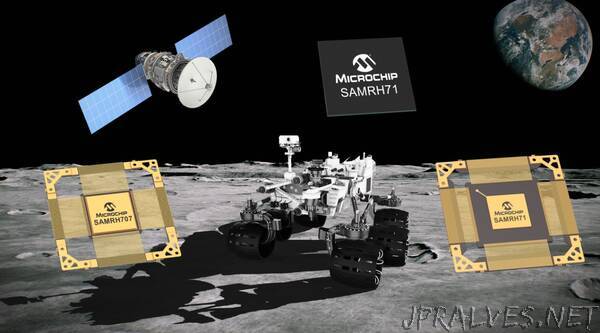
“Designers can benefit from another step in the Arm Cortex-M7-based system-on-chip (SoC) commercial off-the-shelf (COTS) to rad-hard scalable solutions with the addition of embedded analog capabilities
Deep space initiatives including planetary exploration, orbiter missions and space research require innovative spacecraft system technology providing connectivity and processing. To enable system designers better integration and higher performance while reducing development costs and time to market, COTS technologies and scalable solutions are increasingly used in space applications. Microchip Technology Inc. (Nasdaq: MCHP) today announced the qualification of its SAMRH71 Arm-based microprocessor (MPU) and the availability of the SAMRH707 microcontroller (MCU), both implementing ArmÒ CortexÒ-M7 SoC radiation-hardened technology.
“Spacecraft and satellites are expanding in complexity to provide commercial and military operators with robust new communication and data capabilities, greater reliability and faster speeds, while the operators continuously seek to reduce cost, size and weight,” said Bob Vampola, associate vice president of Microchip’s aerospace and defense business unit. “In this environment, lowering system development costs while enabling greater capabilities and space system integration are ever more critical.”
Microchip’s SAMRH71 and SAMRH707 devices were developed with the support of the European Space Agency (ESA) and Centre National D’Etudes Spatiales (CNES), the French space agency, to further research and program initiatives.
“The introduction of Arm technologies for space applications opens up new perspectives by enabling the use of the same ecosystem well in place in the consumer and industrial sectors,” said David Dangla, VLSI Components Expert at CNES. “The SAMRH71 is the first Arm Cortex M7-based rad-hard microprocessor available today on the market. It offers developers the simplicity of a single-core processor and the performance of an advanced architecture without having to implement heavy mitigation techniques as is required for non-space components.”
“Integration of digital-to-analog converters and analog-to-digital converters together with a powerful processor core is a key requirement for addressing new challenges in aerospace applications,” said Kostas Marinis, Onboard Computers Engineer at ESA. “With the SAMRH707, Microchip provides easy-to-use capabilities in cost-effective, radiation-hardened MCUs.”
Relying on the standard Arm Cortex-M7 architecture and the same peripherals as automotive and industrial processors, the SAMRH71 and SAMRH707 provide system development cost and schedule optimization by leveraging standard software and hardware tools from the consumer devices.
The SAMRH71, a radiation-hardened variant of Microchip’s COTS automotive SoC technology, provides a combination of space connectivity interfaces along with high-performance architecture with more than 200 Dhrystone MIPS (DMIPS). Designed for high-level radiation performance, extreme temperatures and high reliability, the SAMRH71’s Arm Cortex-M7 core is coupled with high-bandwidth communication interfaces such as SpaceWire, MIL-STD-1553, CAN FD and Ethernet with IEEE 1588 Generalized Precision Time Protocol (gPTP) capabilities. The device is fully ESCC qualified with support from CNES and compliant with MIL standard Class V and Q high-reliability grades, allowing systems to meet strict compliance requirements.
Extending the portfolio of Microchip’s radiation-hardened Arm Cortex-M7-based MCUs, the SAMRH707 device provides analog functions on top of a >100 DMIPS processor unit with Digital Signal Processing (DSP) capabilities, combined with space connectivity interfaces in a small footprint designed for high-level radiation performance, extreme temperatures and high reliability. The SAMRH707 enables a high level of integration embedding Static Random Access Memory (SRAM) and flash memory, high-bandwidth communication interfaces including SpaceWire, MIL-STD-1553 and CAN FD, along with analog functions such as a 12-bit Analog-to-Digital Converter (ADC) and Digital-to-Analog Converter (DAC).
With space-designed MCUs, MPUs and Field Programmable Gate Arrays (FPGAs), Microchip provides critical elements for the development of new systems. Microchip’s total system solutions span space-qualified, radiation-hardened and radiation-tolerant power, timing and clock devices, as well as connectivity and memory solutions.
Development Tools
To speed system design, developers can use the SAMRH71F20-EK and SAMRH707F18-EK evaluation boards. Microchip’s full ecosystem supports its SAMRH707 and SAMRH71 space processors and includes MPLABÒ Harmony tools suite and third-party software services for space applications. Both Microchip devices are supported by the company’s Integrated Development Environment (IDE) for developing, debugging and software libraries. The devices are supported in MPLAB Harmony version 3.0.
Availability
The SAMRH71 ceramic package device is available in volume production quantities with QMLQ (SAMRH71F20C-7GB-MQ) and QMLV (SAMRH71F20C-7GB-SV) equivalent qualification levels. For applications requiring high volumes and cost-optimized structures, the SAMRH71 is available for printed circuit board design or evaluation in Ball Grid Array (BGA) plastic packaging. The SAMRH707 in a CQFP164 ceramic package is sampling today (SAMRH707F18A-DRB-E).”
